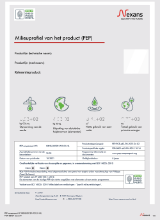- Products
- Markets
- Services & Tools
- Newsroom
- CSR
- Blog
- We are Nexans
- Search
- Contact us
- Compare
- Sign in
Reducing the ecological footprint of products is becoming increasingly important to achieve environmental goals. To choose the right product, it is essential to be able to reliably compare the environmental performance of similar industrial products. Environmental Product Declarations (EPD) are an important tool in this regard. Nexans provides a PEP EcoPassport for most of its products on the Dutch market.
Inhoud:
- What is an EPD
- What is the difference between a PEP and an EPD
- Standards, certification & verification
- How to use a PEP
- Where can I find EPDs?
- Digitalization of EPD data
What is an EPD?
An Environmental Product Declaration (EPD) is a document that provides transparent and roughly comparable information about the environmental impact of products or services.
EPDs are based on a Life Cycle Assessment (LCA) and provide detailed information on the product's environmental performance, including resource consumption, emissions and potential impact on global warming, ozone depletion, acidification of water and soil, and human health.
What is the difference between PEP and EPD?
An EPD (Environmental Product Declaration) is the general term for Type III environmental declarations, as defined by the ISO 14025 standard. PEP stands for Product Environmental Profile and is the common name for the PEP EcoPassport program. PEP EcoPassport is an independent nonprofit organization, co-founded by Nexans.
There are various programs that offer EPDs according to ISO 14025, often specializing in specific product types. The PEP EcoPassport focuses primarily on EPDs for products in the electrical, electronic, and HVAC industries. This specialization allows PEP EcoPassport to address specific environmental concerns related to the use of these types of products.
For example, the PEP EcoPassport specifies how emissions from cables should be calculated during their usage phase (e.g., resistance, temperature, etc.). This is especially relevant when selecting the appropriate cable cross-section. While a larger cross-section has a greater environmental impact during production, it can have a significantly lower environmental impact during the usage phase. Therefore, including the usage phase in the decision-making process for cable dimensions is essential.
Standards, certification, verification and publication
All Nexans PEPs are third-party verified, approved and published by PEP-EcoPassport.
In line with other published EPDs, they are:
- Based on the LCA standard ISO 14040 (how to measure)
- Also based on ISO 14025 (how to communicate footprints).
- Produced according to EN 15804+A1
“ The PEP EcoPassport program allows us to offer an independently verified and certified environmental declaration of our products. This way, together with other manufacturers, we ensure transparency about the environmental performance of industrial products and prevent a proliferation of eco-labels. ”
Pascal Place
Product Manager at NexansHow do I use an EPD or PEP?
To use an EPD or PEP EcoPassport, you should read through the document to understand the environmental impact of the product throughout its life cycle. You can then use this information and assess it against other products or standards. For example, EPDs can be used by:
- Manufacturers: to improve product development and demonstrate environmental responsibility
- Consumers: to make informed choices based on the environmental performance of products
- Construction industry: to achieve sustainable construction projects and fulfil environmental certification requirements
- Governments: to support public procurement and environmental legislation
It is important to note that the fact that a product has a PEP does not necessarily mean that the product is more environmentally friendly. The PEP only says something about HOW environmentally friendly it is.

What information can I get from Nexans Environmental Product Declarations (EPDs)?
Today, most people are interested in the product's climate impact, but we are also seeing a growing interest in resource, water and energy use. These key figures are easily accessible on the front of the PEP for the product's impact throughout its entire life cycle. Otherwise, you can find important info about:
- Properties and description of the product and packaging.
- Functional unit, which is the reference unit in an LCA
- Various parameters such as "lifetime", "resistivity", "energy model for the country of use", etc. that can be used to calculate the product's environmental impact.
- The materials used in the product (percentage of plastics, metals and other materials)
- Information about the PEP issuer.
The PEP document contains a total of 26 environmental impact indicators, such as global warming, waste category, environmental impact and consumption of natural resources. These are also specified per phase:
- Production --> extraction of raw materials, design and manufacturing
- Distribution --> transport and marketing
- Installation --> use of the cables by installers *
- Usage --> lifetime of the installed cable and use by the end customer
- Final treatment --> several possible choices: specific landfills, recovery or recycling
* Note that the "installation" section is not part of the environmental impact analysis. This means that it is actually up to the installer to choose the right products based on the environmental declaration and use them in a sustainable way, especially considering the lifetime of the cable.
From product family to SKU and from Scope 1, 2 & 3 to phases A1, A2, A3 etc.
The EPD is based on a life cycle analysis (LCA) which is very extensive to produce. Therefore, it is produced for a "type cable" within a cable family and the calculations are then extrapolated to other cross-sectional areas or variants of the same cable family using mathematical formulae.
These formulae are provided at the end of the PEP, but it can be time-consuming to calculate this manually.
Therefore, Nexans has calculated CO2 emissions for all phases and SKUs and shared them digitally with the EFO according to the ISO 22057 standard. These figures can easily be extracted from both the PTD (Product Data Template) and the EFO database.
Greenhouse gas emissions or Global Warming Potential (GWP) for Phase A1-A3 cradle to gate is the most commonly used.

The total CO₂ footprint of cables in your project
The demand for environmentally friendly construction products is currently on the rise. The PEP EcoPassport assists installation companies and consultants in selecting products that meet the highest environmental standards, contributing to a more sustainable construction sector.
With the PEP EcoPassport, Nexans can report the total CO₂ footprint per cable. By including this data in our quotations, Nexans enables its customers to make informed choices that contribute to their sustainability objectives. Contact us for more information.
Ecodesign and the development to more sustainable products
Between now and 2040, global electricity demand is expected to increase by 40%. We play a key role at the heart of this electric revolution, where renewable and low-carbon energy sources are vital in an increasingly circular economy. Actively working to reduce our climate impact, we focus on making our production methods more sustainable, increasing the use of recycled materials, and minimizing (cable) waste and packaging.
Ecodesign
For us, Ecodesign is a crucial approach to achieving greater circularity and carbon neutrality. It ensures that from the (re)design phase of cables, we focus on producing less waste while promoting the reuse of raw materials. For example, secondary copper, or recycled copper, has a significantly lower footprint than primary copper. Our goal is to incorporate 30% recycled copper into our cables by 2030, and we are also exploring developments toward cables made with 100% recycled materials.
By integrating these improvements into the PEP EcoPassport, we can effectively demonstrate the tangible progress we are making.
PEP EcoPassports' in our catalogue
Nexans EPDs (or PEPs) in PFD format at product family level can be found:
- published here under
- On the PEP EcoPassport website
- on our website under each product:
- H07V-U Eca in VDbox
- H07V-U / H07V-R
- H07Z1-U Cca
- YMvK Dca-s2
- YMvK ss Dca-s2 Ultraflex
- VO-YMvkas Dca-s2 and VG-YMvKas Dca-s2
- YMz1K Cca
- YMz1K ss Cca
- YMZ1K B2ca
- YMZ1Kss B2ca
- Z1O-YMz1Kas B2ca
- Z1G-YMz1Kas B2ca
- TITANEX
- LINEAX H07RN-F
All PEP EcoPassports'
Our websites
Select your country to find our products and solutions
-
Africa
- Africa
- Ghana
- Ivory Coast
- Morocco
- North West Africa
- Americas
- Asia
- Europe
- Oceania


